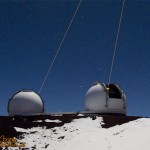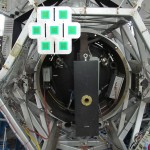When you shine a powerful laser into the sky, someone is likely to notice.
That someone is likely to be the Federal Aviation Administration, who, for some reason, seem to be concerned about the possibility of our illuminating a passenger airliner with an AO laser.

Enter TBAD, the Transponder Based Aircraft Detector. All commercial and most civil aircraft carry a 1090MHz ADS-B transponder that identifies the aircraft and provides basic data. The transponder is part of an aircraft tracking system now used by air traffic control centers around the world to supplement, or in some cases replace, radar systems. An idea… Create a directional antenna that can determine if a 1090MHz transmitter is in the beam of the antenna and mount that antenna to the telescope. With such a system we can detect an aircraft approaching our beam and shutter the laser. The idea was conceived by Tom Murphy and Bill Coles at the University of California San Diego. Thus TBAD can alternately mean Tom and Bill’s Aircraft Detector.
They built one of these systems and installed in California, but there was no large drive to push the system to completion. Somewhere along the line some folks at Keck heard about the device and offered to help test the system, put some money in to build additional hardware, and help with the necessary FAA approval process. Given a pair of lasers that are on-sky five to twelve days each month, we need this capability. There is also a financial incentive here, fielding the system will eliminate tens of thousands of dollars spent on hiring laser spotters each year. With the promise of a more reliable and accurate method of detecting aircraft as the the goal, TBAD came to Keck.

With initial testing complete, it was time to mount the system on a telescope and use it under real world conditions. Now the work starts… Design the system, including an antenna mount, write the engineering change requests. Convince the Telescope Configuration Control Board that bolting the system to the telescope will not harm anything, never an easy task. Do all the paperwork, and maybe, sometime I get to install something… Done.
One problem with mounting TBAD to the telescope, is that aircraft over the summit of Mauna Kea are really quite rare. We expect to encounter aircraft in the beam only a few times (or less) each year. The advantage is that the system can operate any time the dome is open, not just when using the laser. With any luck we will get a few more events.
Approval by the FAA is the real challenge here. The FAA is an extraordinarily conservative organization, rightly so with aircraft safety involved. We need data, lots of it, enough to prove our case and show that the system is effective and reliable. This is an ongoing process. We gathered a great deal of data with the system on the roof of the observatory, or setup in Waimea. We need to gather more with the system on the telescope. One advantage is that we are taking advantage of an FAA designed and mandated system, not something out of the blue, something they are familiar with and trust. With data to back up our case, we should be able to gain approval. I expect that TBAD will become standard equipment on telescopes that use AO lasers around the world.


I am wondering about the comparison of TBAD detected aircraft and Kailua-Kona flight records. How do you account for high altitude international flights, military aircraft and a possible curious UFO following the beam?
TBAD will shutter the laser if the aircraft passes within 15 degrees of the beam. Of course, a high altitude aircraft will take much longer to traverse this region, creating a wide safety margin. This is our primary concern and the usual situation we discover in mining years of flight data.
An aircraft skimming the summit might be able to cross the area faster than the system can respond, yet flight data shows no such event has happened recently. There is a point that a pilot is taking risks into their own hands. The standard aviation charts clearly warn pilots of lasers in use over the summit.
Military aircraft can turn off their transponder, but do not do this in controlled airspace during peacetime, to do so would create a hazard to commercial aircraft using the same airspace.
UFO’s are on their own.
Hello It is now 2016. Have you gotten approval from the FAA yet for this way of shitting down lasers?
I have an immediate need for this technology. Thanks
What we have is not really an approval, but what the FAA calls a “letter of no objection”, which really amounts to the same thing. We are operating with TBAD and no spotters, have been for a couple years now.